Naksansa Temple: A Must-Visit Destination in Yangyang, Gangwon-do
100 Naksansa-ro, Ganghyeon-myeon, Yangyang-gun, Gangwon-do, South Korea

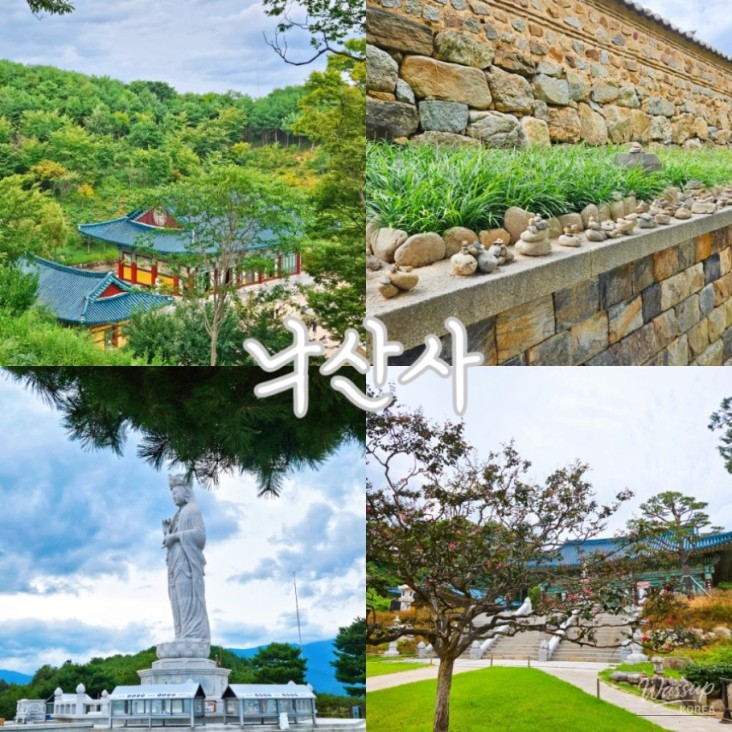
Naksansa Temple: A Must-See in Yangyang, Gangwon-do
Filming Location of the Korean Drama 'Taejo Wang Geon'
[Text & Photos] Traveler Yije Life
Hello,
This is Yije, capturing every corner of Korea in detail :)
Today, I'm excited to share a post about Naksansa Temple in Yangyang, which I was most looking forward to on my Gangwon-do trip.
Naksansa Temple is a landmark representing Yangyang, so it's a must-visit destination. It's a place of great historical value, offering stunning views of the East Sea at a glance.
Naksansa Temple also offers a Templestay program. Let me introduce everything from the entrance fee to parking information!
Address: 100, Naksansa-ro, Ganghyeon-myeon, Yangyang-gun, Gangwon-do, Republic of Korea
Operating Hours: Open year-round: 06:00 - 17:30 (Exit by 18:30)
Parking: Available (Free and Paid options – details below)
1. Naksansa Temple Parking
There are two parking areas: Naksansa Temple Entrance and Uisangdae Parking Lot. Paid parking costs ₩5,000. I parked at the Naksansa Temple Entrance. (Kiosk unmanned payment system)
Free parking is available if you use Naksan Beach, but there is a downside of having to walk uphill. Keep this in mind if you want to park for free.

2. Yangyang Templestay Inwolryo
Enter through the Sanmun Gate at the entrance of Naksansa Temple.

Pass through a lush green path.

Inwolryo appears.
Only Templestay participants can enter. If you want to visit Chwisureokheon, you need to go further up the path.
Templestay programs are available in both relaxation and experience types, with various programs prepared.
If you are interested in Templestay, please refer to the Naksansa Temple website.
3. Hongyemun Main Gate Ticket Office & Admission Fee

After passing Inwolryo and enjoying the breeze, you will arrive at the Hongyemun Main Gate Ticket Office.
Hongyemun is Gangwon-do Tangible Cultural Heritage No. 33. It is said to have been built in 1467 (the 13th year of King Sejo's reign). It was destroyed by a large fire in 2005 and rebuilt in 2006.
Next to it, you can see the entire map of Naksansa Temple.
Admission is free from May 4, 2023, due to the revision of the Cultural Heritage Protection Act. The cool weather makes it perfect for a trip near Sokcho :)
Naksansa Temple Course

Take a look at the map and read the explanations as you go up.
Although the weather was cloudy, Naksansa Temple was so beautiful and peaceful ⛰️

It is located on the slopes of Mt. Obong, one of the three major mountains in Gwandong, along with Mt. Geumgang and Mt. Seorak. It is a sacred site of Avalokitesvara.
4. The Path Where Dreams Come True

On the way to see the Haesu Gwaneum Statue, you pass the Path Where Dreams Come True.
Seeing the many stacked stone towers, I felt like my dreams would really come true ㅎㅎ
At first, I didn't know there was a Haesu Gwaneum Statue at Naksansa Temple, but as I was walking, I was so surprised and asked, "What's that?" I followed it like a lighthouse ????

The walking path had a strong autumn vibe. I want to come back for a domestic autumn trip with my grandmother ????
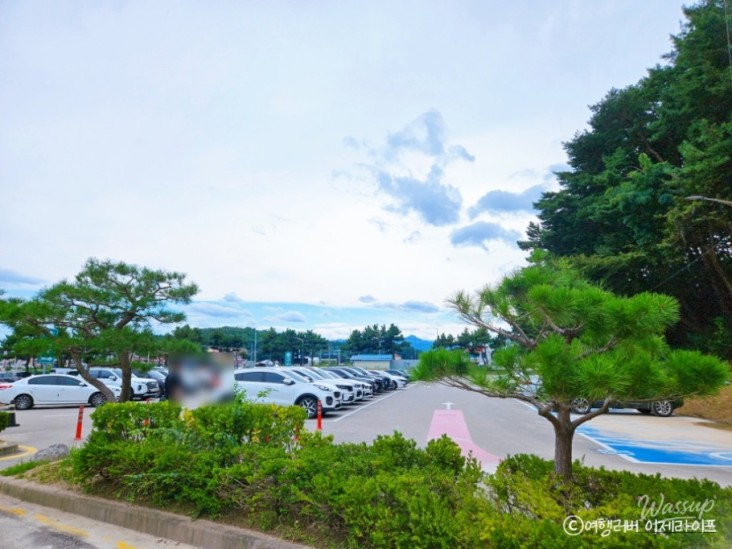
5. Haesu Gwaneum Statue (Avalokitesvara Bodhisattva of the Sea)
The Haesu Gwaneum Statue is the most widely known treasure of Naksansa Temple to the general public.

Even if you are not a believer, if you come to the East Sea and visit Naksansa Temple, it has become a course to stop by and pay respect.
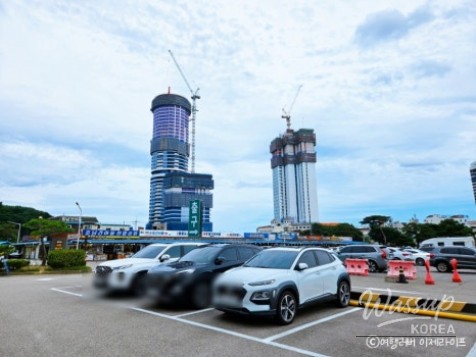
The sea and sky spread out before you, creating an unparalleled view.
The Haesu Gwaneum Statue was first started in 1972 and enshrined on November 6, 1977, after 5 years. At the time, the chief monk, Woncheol, transported about 700 tons of high-quality granite from Iksan, Jeollabuk-do, which is considered the best granite production area in Korea, carved out 300 tons, and created the statue.
Next to the Gwaneum Statue, there was a bell. I thought only officials could ring it, but it turned out that anyone could ring it...!! (Me, finding out while writing this post)
Around the Haesu Gwaneum Statue, there are chairs where you can sit and look at the sea.
Sitting and gazing at the East Sea, I felt a sense of peace.
If it were closer, I would come here so often~
6. Botajeon Hall

Botajeon Hall, along with Wontongbojeon Hall and the Haesu Gwaneum Statue, symbolizes Naksansa Temple as a sacred site of Avalokitesvara belief and a representative Avalokitesvara sanctuary in Korea.

Inside Botajeon Hall, 7 Avalokitesvara statues such as Thousand-Armed Avalokitesvara, Holy Avalokitesvara, and Eleven-Faced Avalokitesvara, as well as 32 Transformation Body Statues and 1,500 Avalokitesvara statues are enshrined.
It is a sacred site of Avalokitesvara belief, where all Avalokitesvara statues are enshrined.
If you go down the stairs, you can look around the souvenir shop.
There are spaces in between where you can drink free tea and coffee. (Another thing I didn't know,,, hehe)
7. Gwaneumji Pond

This is Gwaneumji Pond, where you can see lotus flowers and lotus leaves~

It seems like many people throw coins here. I realize once again that I should carry coins every time I come to a temple ????

8. Back Gate Ticket Office (Uisangdae Parking Lot)

It started to rain a little, so I couldn't go back the way I came and went towards the Uisangdae Parking Lot. Fortunately, there was a pink sign indicating the way to the Naksansa Temple entrance.

The parking attendant told me that it was an expensive sign ㅎㅎ

It was a quick 10-15 minute walk!

There were pretty cafes in between, so I wish the weather had been better so I could have stayed more leisurely at Naksansa Temple.

It started to rain heavily as soon as I got in the car, so I thought I was lucky ????????

















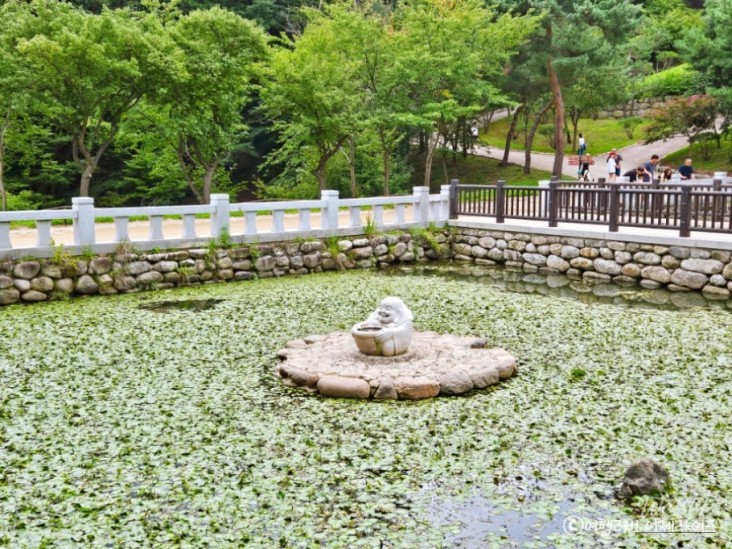

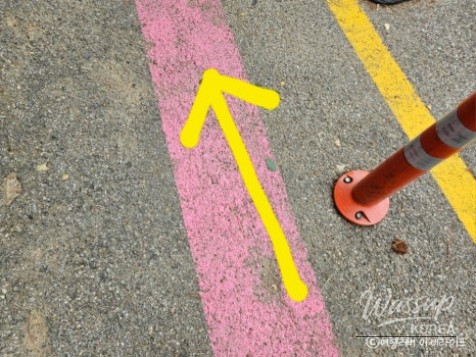






If you are planning a trip to Yangyang or an autumn getaway, I highly recommend visiting Naksansa Temple.
I hope you have an exciting trip exploring every corner of Korea today :)
Copyright 2025. Traveler Yije Life All rights reserved.
Other Photos
No comments yet.






